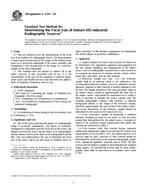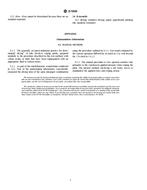1.1 These test methods cover the determination of the breaking load and calculated flexural strength of a rectangular cross section of a preformed block-type thermal insulation tested as a simple beam. It is also applicable to cellular plastics. Two test methods are described as follows:
1.1.1 Test Method I – A loading system utilizing center loading on a simply supported beam, supported at both ends.
1.1.2 Test Method II – A loading system utilizing two symmetric load points equally spaced from their adjacent support points at each end with a distance between load points of one half of the support span.
1.2 Either test method is capable of being used with the four procedures that follow:
1.2.1 Procedure A – Designed principally for materials that break at comparatively small deflections.
1.2.2 Procedure B – Designed particularly for those materials that undergo large deflections during testing.
1.2.3 Procedure C – Designed for measuring at a constant stress rate, using a CRL (constant rate of loading) machine. Used for breaking load measurements only.
1.2.4 Procedure D – Designed for measurements at a constant crosshead speed, using either a CRT (constant rate of traverse) or CRE (constant rate of extension) machine. Used for breaking load measurements using a fixed crosshead speed machine.
1.3 Comparative tests are capable of being run according to either method or procedure, provided that the method or procedure is found satisfactory for the material being tested.
1.4 These test methods are purposely general in order to accommodate the widely varying industry practices. It is important that the user consult the appropriate materials specification for any specific detailed requirements regarding these test methods.
1.5 The values stated in SI units are to be regarded as the standard. The values given in parentheses are provided for information only.
1.6 This standard does not purport to address all of the safety concerns, if any, associated with its use. It is the responsibility of the user of this standard to establish appropriate safety and health practices and determine the applicability of regulatory limitations prior to use. For specific precautionary statements, see Section 11.
Product Details
- Published:
- 11/01/2005
- Number of Pages:
- 7
- File Size:
- 1 file , 94 KB
- Redline File Size:
- 2 files , 180 KB


